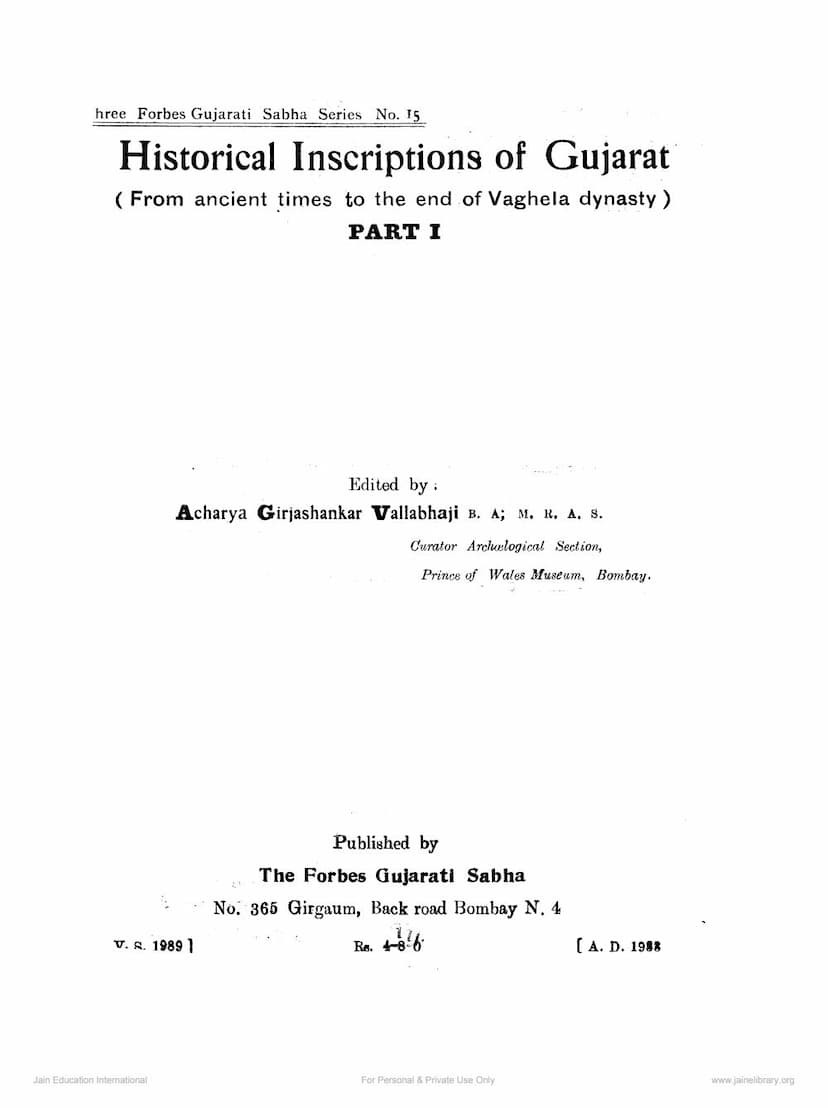Gujarat Na Aetihasik Lekho Part 01
Added to library: September 1, 2025

Summary
Here is a comprehensive summary of the Jain text "Gujarat na Aetihasik Lekho Part 01," based on the provided pages:
Book Title: Gujarat na Aetihasik Lekho Part 01 Author(s): Girjashankar Vallabh Acharya Publisher: Farbas Gujarati Sabha Catalog Link: https://jainqq.org/explore/005412/1
Overall Summary:
"Gujarat na Aetihasik Lekho Part 01," edited by Acharya Girjashankar Vallabhaji, is a foundational scholarly work published by The Forbes Gujarati Sabha, Bombay. This volume aims to compile and present historical inscriptions, copperplates, and other significant writings related to Gujarat from ancient times up to the end of the Vaghela dynasty. The first part of this series focuses on the period from ancient times to the conclusion of the Vaghela dynasty.
The project was initiated with the idea of collecting historical materials by the late Mr. Ranjitram Vavabhai, whose collection was later purchased by the Forbes Gujarati Sabha. The current volume is the result of careful editing and annotation by Mr. G. V. Acharya, Curator of the Archaeological Section at the Prince of Wales Museum, Bombay.
The preface highlights the Sabha's commitment to promoting historical research through a series of publications. This book is presented as a crucial part of that initiative, with other published works including "Prabandha Chintamani," "Chaturvinshati Prabandha," and various treatises on Gujarat's history, dynasties, fortresses, and religious sects. The Sabha also anticipates future publications, including translations and works on Buddhist religion in Gujarat.
Key Content and Themes:
The primary focus of this volume, as evidenced by the table of contents and detailed descriptions, is the collection and presentation of historical inscriptions and edicts. The text meticulously lists and analyzes various inscriptions, providing details such as:
- Inscriptions of Maurya King Ashoka's Dharmashasanas: A significant portion of the book is dedicated to the famous rock inscriptions of Emperor Ashoka found near Junagadh. The text details their location, physical description, and the historical context of their carving. It includes the Gujarati translation and transliteration of Ashoka's Edicts (Shasan 1 to 14), covering topics like principles of governance, welfare measures, religious tolerance, and the consequences of war. The inscriptions are presented with their original Prakrit text and a Gujarati translation, highlighting their importance for understanding ancient Indian history and governance.
- Inscriptions of the Kshatrapat Dynasty: The volume details inscriptions from the time of rulers like Rudradaman, Rudrasimha, and Rudrasena, including the significant Junagadh rock inscription attributed to Mahakshatrap Rudradaman. These inscriptions often relate to the repair of the Sudarshan Lake and provide insights into the administrative and political landscape of Gujarat during the period.
- Inscriptions of the Gupta Dynasty: The book includes the inscription of Skandagupta, which also refers to the Sudarshan Lake and its repairs, offering a link to the administrative practices of the Gupta era.
- Inscriptions of the Vallabhi Dynasty: A substantial section is dedicated to the inscriptions of the Vallabhi rulers, such as Dronasimha, Dhruvasena I, and various Shiladityas. These inscriptions provide crucial information about their reigns, land grants, administrative divisions, and religious policies.
- Inscriptions of the Chalukya Dynasty: The volume also includes inscriptions from the Chalukya period, mentioning rulers like Vijayaraja and Jayasingha.
Methodology and Editorial Approach:
Acharya Girjashankar Vallabhaji's editing emphasizes:
- Collection and Preservation: The compilation aims to gather inscriptions that were published in various journals or were in private collections, thereby creating a consolidated and accessible resource.
- Annotation and Translation: The inscriptions are presented with their original script (where applicable), transliteration, Gujarati translation, and critical annotations, providing historical context and scholarly analysis.
- Accessibility: The publication aims to make these historical sources available to scholars and the general public interested in Gujarat's past, often at a subsidized price for educational institutions.
- Addressing Challenges: The editor acknowledges the difficulties in deciphering ancient scripts, the potential for missing inscriptions due to lack of information, and the presence of forged inscriptions that might still contain historical value. The text explains the methodology used for numbering and referencing the inscriptions to facilitate future additions and research.
Overall Significance:
This book serves as an invaluable repository of primary historical sources for understanding the political, social, religious, and administrative history of Gujarat. By presenting these inscriptions in a systematized and annotated format, it lays the groundwork for further in-depth research into the region's rich and complex past. The commitment of The Forbes Gujarati Sabha and the expertise of the editor are evident in making these foundational historical documents accessible to a wider audience.